An Air China flight on Saturday was forced to make an emergency landing after a lithium battery in a passenger's carry-on luggage caught fire. The incident occurred in the overhead bin during a flight from Hangzhou, China, to Incheon, South Korea. Air China confirmed that there were no injuries among passengers or crew.
The spontaneous combustion of the battery led to smoke filling a section of the aircraft cabin, causing concern among those on board. Flight crew members acted quickly to manage the situation.
Key Takeaways
- Lithium battery ignited in overhead bin on Air China flight.
- Flight from Hangzhou, China, to Incheon, South Korea.
- No injuries reported among passengers or crew.
- Crew responded quickly to the incident.
- The specific type of battery or device involved is not yet clear.
Incident Details on Air China Flight
The event took place on Saturday, October 18, 2025. An Air China flight was en route from the city of Hangzhou, China, to Incheon, South Korea. The airline reported that a lithium battery inside a passenger's carry-on bag spontaneously ignited.
The bag was stored in an overhead compartment. This type of incident poses significant safety challenges in aviation due to the potential for rapid fire spread and smoke generation in a confined space.
Crew Response and Passenger Safety
Air China stated that its crew members responded promptly to the fire. Their quick actions were crucial in managing the situation and preventing further escalation. The airline emphasized that passenger and crew safety remained the top priority throughout the emergency.
No one sustained injuries as a direct result of the battery fire or the subsequent emergency procedures. This outcome highlights the importance of trained cabin crew in handling onboard emergencies.
"The airline said there were no injuries," confirmed a statement from Air China regarding the incident.
Fact: Lithium Battery Risks
Lithium-ion batteries are common in many portable electronic devices, including smartphones, laptops, and power banks. While generally safe, they can pose a fire risk if damaged, defective, or exposed to extreme temperatures. These batteries can enter a state known as 'thermal runaway,' where they rapidly heat up, leading to fire or explosion.
Visual Evidence and Public Reaction
Video footage circulating on social media platforms captured scenes from inside the aircraft. These videos showed the overhead bin on fire, with thick smoke filling parts of the cabin. The images conveyed a sense of alarm among passengers.
Such visuals often spread quickly online, raising public awareness about aviation safety issues. The footage served as a stark reminder of the potential dangers associated with certain items carried on flights.
Uncertainty Regarding Battery Type
It remains unclear whether the ignited battery was part of an electronic device or a standalone spare battery. This distinction is important for understanding the specific circumstances of the fire. Aviation regulations often have different rules for loose lithium batteries compared to those installed within devices.
Investigations typically aim to determine the exact cause of such incidents. This helps airlines and regulatory bodies refine safety protocols and passenger guidelines.
Context: Aviation Regulations
Aviation authorities worldwide have strict regulations regarding the transport of lithium batteries. Passengers are usually advised to carry spare lithium batteries in their carry-on luggage, not in checked bags, to allow for immediate intervention if an incident occurs. Devices containing lithium batteries are also subject to specific packing rules and quantity limits.
Impact on Air Travel Safety
Incidents involving lithium batteries underscore ongoing challenges for the aviation industry. Airlines and regulators continuously evaluate and update safety measures to mitigate these risks. Education for passengers on proper battery handling and storage is a key component of these efforts.
The event on the Air China flight serves as a reminder for travelers to be aware of regulations concerning electronic devices and batteries when flying. Adhering to these rules helps ensure the safety of everyone on board.
Preventative Measures and Future Outlook
Airlines often provide guidance on their websites and during the boarding process about items that pose potential hazards. These guidelines are based on international aviation safety standards. Continuous research is also underway to develop safer battery technologies and improved fire suppression systems for aircraft cabins.
The Air China incident, while resolved without injury, will likely contribute to ongoing discussions about aviation safety protocols for portable electronic devices and batteries.
- Always check airline regulations regarding lithium batteries before flying.
- Carry spare batteries in your carry-on, not checked luggage.
- Ensure devices are turned off or in sleep mode when not in use.
- Report any unusual heat or smell from a device to flight attendants immediately.
According to the International Air Transport Association (IATA), incidents involving lithium batteries on aircraft are a growing concern. They advocate for stronger regulations and better public awareness.
The investigation into the specific battery and device involved in the Air China incident is expected to provide more information. This data will help inform future safety recommendations for air travel.





